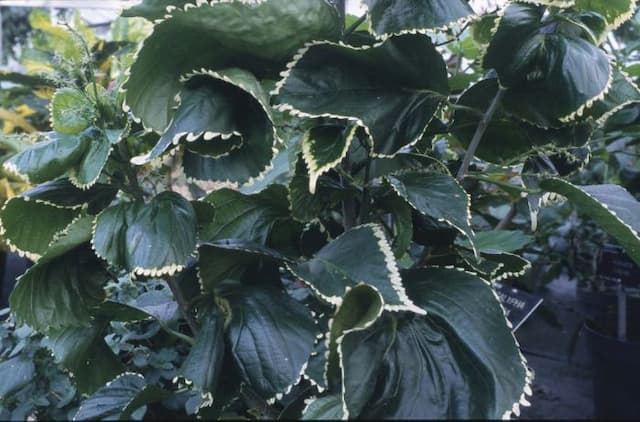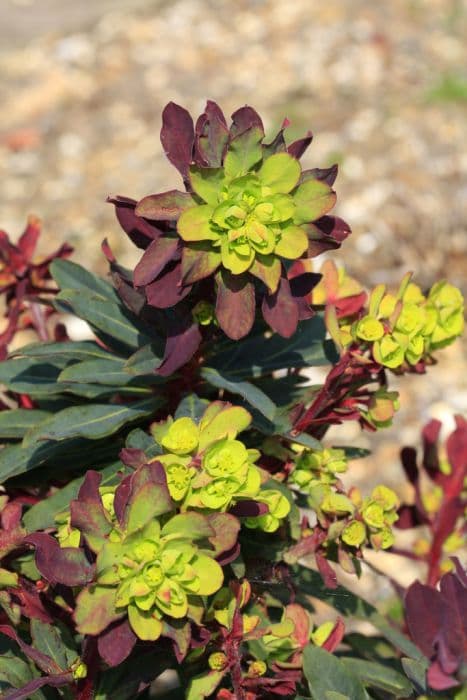Sikkim Spurge Euphorbia sikkimensis

ABOUT
Euphorbia sikkimensis, commonly known as Himalayan Spurge, showcases a striking appearance that is characterized by its lush green to reddish-purple foliage and unique inflorescence. The leaves of this plant are elongated, with a slim and pointed tip, creating a graceful arching effect. During the different seasons, these leaves may change in color, starting from a bright green in their youth and maturing to exhibit reddish or purplish hues, giving the plant a vibrant and dynamic appearance. Himalayan Spurge produces clusters of very small, cup-shaped flowers, which are technically referred to as cyathia, a special feature of plants in this genus. These flowers have a striking visual appeal due to their contrast with the foliage, commonly displaying a yellow or greenish-yellow color. These cyathia are typically surrounded by showy, petal-like bracts, which may be mistaken for petals by those unfamiliar with the plant. Roots of the Himalayan Spurge are thick and tuberous, anchoring the plant firmly in the ground. Its overall form is robust and sturdy, allowing it to stand out prominently in garden settings. The combination of its colorful foliage and distinctive flowers makes Euphorbia sikkimensis a popular choice for gardeners looking to add an exotic touch to their landscapes.
About this plant
 Names
NamesFamily
Euphorbiaceae
Synonyms
Sikkim Spurge
Common names
Euphorbia sikkimensis.
 Toxicity
ToxicityTo humans
Euphorbia sikkimensis, commonly known as Himalayan Spurge, is toxic to humans if ingested or if its sap comes into contact with skin or mucous membranes. The plant contains a white, milky latex that can cause skin irritation, burning, redness, and swelling upon contact. If the latex gets into the eyes, it can cause severe pain and possibly temporary blindness. If ingested, the toxic components can lead to symptoms such as nausea, vomiting, diarrhea, and abdominal pain. In severe cases, it may cause inflammation of the throat and mouth, difficulty swallowing, and systemic reactions. It is advised to handle this plant with care and seek medical attention in case of accidental ingestion or if the latex comes into contact with eyes or mucous membranes.
To pets
Himalayan Spurge is also toxic to pets, with both cats and dogs being susceptible to its poisonous effects. Similar to humans, the ingestion of any part of the plant can result in vomiting, diarrhea, and possibly more severe gastrointestinal distress. It is crucial to prevent pets from chewing on or ingesting the plant. If the latex comes into contact with a pet's skin, it can cause irritation and dermatitis. If you suspect your pet has ingested Euphorbia sikkimensis or is showing signs of poisoning, it is important to contact a veterinarian immediately.
 Characteristics
CharacteristicsLife cycle
Perennials
Foliage type
Deciduous
Color of leaves
Green
Flower color
Yellow
Height
4 feet (1.22 meters)
Spread
2 feet (0.61 meters)
Plant type
Herb
Hardiness zones
6
Native area
Himalayas
Benefits
 General Benefits
General Benefits- Ornamental Appeal: Euphorbia sikkimensis, commonly known as Himalayan Spurge, is appreciated for its striking foliage and structural form, adding aesthetic value to gardens and landscapes.
- Drought Tolerance: Once established, Himalayan Spurge is quite resilient to drought, making it suitable for xeriscaping or regions with low rainfall.
- Low Maintenance: This plant generally requires minimal care, thriving without the need for extensive upkeep, which can be beneficial for busy gardeners and landscapers.
- Attracts Pollinators: Euphorbia sikkimensis can attract pollinators such as bees and butterflies, which are essential for the pollination of many plants and the overall health of ecosystems.
- Deer Resistance: The sap and overall plant structure of Himalayan Spurge tend to deter deer, making it useful for gardens in areas where deer browsing is a problem.
- Seasonal Interest: With its changing leaf colors throughout the seasons, from green to red or yellow tones, Himalayan Spurge offers visual interest throughout the year.
- Erosion Control: The root system of this plant can help to stabilize soil and prevent erosion on slopes or banks, which is particularly valuable in certain landscapes.
- Adaptability: Himalayan Spurge can adapt to a variety of soil types and conditions, although it prefers well-draining soils, which is convenient for different garden scenarios.
- Companion Planting: This plant works well with other perennials in a garden setting, allowing for diverse and complementary plant combinations.
 Medical Properties
Medical Properties- Anti-inflammatory: Euphorbia sikkimensis may contain compounds that help reduce inflammation.
- Analgesic: Some species of Euphorbia have been used for their pain-relieving properties, which might apply to Euphorbia sikkimensis as well.
- Antimicrobial: Compounds in Euphorbia sikkimensis might exhibit antimicrobial activity against certain pathogens.
- Antioxidant: The plant could have antioxidant effects, providing protection against oxidative stress.
- Wound healing: Extracts from Euphorbia sikkimensis may promote wound healing due to potential antiseptic and growth-stimulating properties.
 Air-purifying Qualities
Air-purifying QualitiesThis plant is not specifically known for air purifying qualities.
 Other Uses
Other Uses- Euphorbia sikkimensis, commonly known as Himalayan Spurge, can be used in perennial borders to provide architectural interest with its upright, red-tinted stems and lance-shaped leaves.
- The milky sap of Himalayan Spurge can be used as a waterproofing agent for containers made of natural materials, although it should be handled with care due to its irritant properties.
- In garden design, Himalayan Spurge serves as a striking contrast plant against green foliage or brightly colored flowers when planted in clusters or as an accent plant.
- Due to its unique appearance, Himalayan Spurge is used in floral arrangements to add an exotic touch, often in dried form because of its ability to retain its shape and color.
- The Himalayan Spurge's sap has been traditionally used to remove warts, but it can be risky and should be applied with caution to avoid skin irritation.
- Horticulturally, cultivars of Euphorbia sikkimensis are utilized in breeding programs to develop new garden varieties with specific desirable traits like leaf color or plant hardiness.
- As an ornamental plant, Himalayan Spurge is used to create garden sculptures by training and pruning its stems in specific patterns for visual interest.
- In cottage gardens, Himalayan Spurge adds an element of rustic charm, blending effortlessly with other country style perennials and grasses.
- The tall structure of Himalayan Spurge can be used as a natural trellis for supporting lightweight climbing plants or vines in a garden setting.
- Photographers and painters often use Himalayan Spurge as a subject for their work due to its striking form and vivid seasonal color changes.
Interesting Facts
 Feng Shui
Feng ShuiThe Himalayan spurge is not used in Feng Shui practice.
 Zodiac Sign Compitability
Zodiac Sign CompitabilityThe Himalayan spurge is not used in astrology practice.
 Plant Symbolism
Plant Symbolism- Resilience: Euphorbia sikkimensis, commonly known as Himalayan Spurge, often grows in challenging mountainous regions, symbolizing its ability to endure tough conditions and thus representing resilience.
- Protection: Many Euphorbia species exude a milky sap when cut or damaged, which is toxic and irritating to skin and mucous membranes. This can symbolize protection, as the plant has its own natural defense mechanism.
- Adaptability: As a plant that can thrive in different environments, Himalayan Spurge epitomizes adaptability, adjusting to various conditions and prospering.
- Renewal: Since Euphorbias tend to be quite hardy and can bounce back even after harsh winters or dry spells, they are often associated with renewal or rebirth.
- Purification: The genus Euphorbia is often said to have purifying qualities, possibly because some cultures have used Euphorbia plants in herbal medicine to cleanse the body of toxins.
 Water
WaterHimalayan Spurge should be watered when the top inch of soil feels dry to the touch, which typically means once every week or two, depending on climate conditions. For indoor plants, use about 16 ounces of water for a medium-sized pot during each watering session. Outdoor plants may require up to 2 gallons of water, depending on the size of the plant and environmental factors. Avoid waterlogging by ensuring the pot has good drainage, and reduce watering frequency in the winter months when the plant is not actively growing.
 Light
LightHimalayan Spurge thrives in partial to full sunlight conditions, favoring a spot that receives several hours of direct sunlight but is protected during the hottest part of the day. Ideal locations include east or west-facing gardens that provide some afternoon shade, or a bright spot indoors near a window with filtered light.
 Temperature
TemperatureHimalayan Spurge prefers temperatures between 60°F and 75°F but can withstand temperature fluctuations from about 40°F to 80°F. Avoid placing the plant in locations where temperatures drop below 40°F as it may damage the plant. The ideal condition is a consistent, moderate temperature without exposure to frost.
 Pruning
PruningPrune Himalayan Spurge to remove any yellowing or dead leaves and to maintain its shape. This is typically done in late winter or early spring before new growth begins. Cut back any stems that are overgrown or detracting from the plant’s appearance. Pruning once a year is usually sufficient for the health and aesthetics of the plant.
 Cleaning
CleaningAs needed
 Soil
SoilHimalayan spurge thrives in well-draining soil with a pH range from 6.0 to 7.5. A mix of loam, sand, and peat is ideal, providing good drainage and aeration. To create an optimal soil mix, combine 60% loam, 30% sand, and 10% peat or compost to enrich the soil and maintain slight acidity.
 Repotting
RepottingHimalayan spurge should be repotted every two to three years. This frequency allows for refreshing the soil and checking the root health. It's best to repot in spring before the growing season begins.
 Humidity & Misting
Humidity & MistingHimalayan spurge prefers moderate humidity levels. Although it can tolerate a range of humidity conditions, it thrives best when humidity levels are between 40% and 60%.
 Suitable locations
Suitable locationsIndoor
Place Himalayan spurge in bright, indirect light indoors.
Outdoor
Plant Himalayan spurge in partial sun, shelter from strong winds.
Hardiness zone
7-9 USDA
 Life cycle
Life cycleEuphorbia sikkimensis, commonly known as Sikkim spurge, begins its life cycle with seed germination, typically occurring in the spring when temperatures are suitable for growth. After germination, the seedlings establish themselves with a basic root system and grow into juvenile plants, developing characteristic foliage and structure. As the plants mature, they form a robust root system and produce their distinct foliage, with leaves that have a reddish mid-rib. The mature Sikkim spurge then blooms in the summer, producing greenish-yellow flowers that are structured in cyathia, a typical Euphorbia flowering arrangement. After pollination, usually by insects, the plant develops seed capsules that, when ripe, burst open to disperse seeds for the next generation. The plant may also propagate vegetatively through division or cuttings, supplementing its reproductive strategy and ensuring the continuation of the species.
 Propogation
PropogationPropogation time
Spring-summer
Propogation: Euphorbia sikkimensis, commonly known as Himalayan Spurge, is typically propagated through seed sowing. The optimal time to propagate this plant is in late winter to early spring when you can start the seeds indoors. To propagate Himalayan Spurge by seeds, sow them on the surface of a well-draining soil mixture, preferably in a flat tray or pot. It's beneficial to press the seeds gently into the soil to ensure good contact but avoid covering them with more soil because they need light to germinate. Keep the soil lightly moist but not wet, and provide a consistent temperature of around 70 degrees Fahrenheit (21 degrees Celsius). Germination can take anywhere from three weeks to a month. Once seedlings have emerged and are large enough to handle, they can be transplanted into individual pots.



![Spurge [Blackbird]](/_next/image?url=https%3A%2F%2Fplants-admin.emdemapps.com%2Fimages%2Fplants%2F%2Fimages%2F604b535f37783.png&w=640&q=75)





